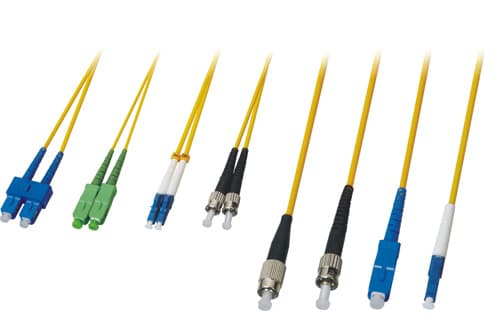
There are two classes of Optical Fiber:
Single-Mode Fiber: generally called SMF, it is used for long distance communication
Multi-Mode Fiber: generally called MMF, it is used for short distances less than 500 meters
The advantage of MMF is that it is cheaper than SMF, and multimode connectors are cheaper and easier to terminate reliably in the field.
In recent years, there are new optical cables called active optical cables (AOC). These have the optical electronics already connected, eliminating the connectors between the cable and the optical transceiver. They will plug into standard optical transceiver sockets. Because of the manufacturer can match the electronics to the required length and type of cable, the cost of these new active optical cables is lower than other optical solutions, therefore more and more applications are deployed.
There are different types of fiber optic fiber depending on the type of network and transfer distances:
10GBASE-SR – a port type for short range multimode fiber that covers the following distances based on the grade of optical fiber cabling:
FDDI -62.5 microns, reach of approximately 26 meters
OM1 62.5 microns – a reach of approximately 33 meters
OM2 50 microns – a reach of approximately 82 meters
OM3 50 microns – a reach of approximately 300 meters
OM4 50 microns – a reach of approximately 400 meters
In fact, most of the implementations prefer to OM3 and OM4 for fiber optical cabling to longer transfer distance.
10GBASE-LR: a port type for long range single-mode fiber, supports the reach of approximately 10 kilometers (6.2 miles).
10GBASE-LRM: a port type for long range multi-mode fiber, supports distances up to approximately 220 meters.
10GBASE-ER: a port type for extended reach single-mode fiber, supports the reach of approximately 40km.
10GBASE-ZR: a port type for non-standard extended reach single-mode fiber, supports the reach of approximately 80km.
10GBASE-LX4: a port type for multimode fiber and single-mode fiber, supports reach of approximately 300 meters (980 ft) over FDDI-grade, OM1, OM2, and OM3 multi-mode cabling and 10 kilometers ( 6.2 miles ) over SMF.
SFP+ Direct Attach
Also known as 10G SFP+ Cu, 10GBase-CR, or 10GBase-CX1, SFP+, or 10GbE Cu SFP cables.
SFP+ Direct Attach Cable uses a copper 10GbE cable that comes as active or passive twin-ax cable assembly and connects directly into an SFP+ housing.
Active cables are copper cables that have a silicon chip to boost the performance of the cable. Without a chip, the cable is considered a ‘passive’ cable. Passive cables are more susceptible to degradation due to attenuation and crosstalk. This active boosting allows cables to be more compact, thinner, longer, and transmit data faster than their passive equivalents.
SFP+ Direct Attach Cable has a fixed-length cable, typically 3, 5 or 7m in length, and like 10GBASE-CX4, is low power, low cost and low latency with the added advantages of using less bulky cables and of having the small form factor of SFP+.
Passive = 1, 3, 5 Meters
Active = 7, 10,12,15 Meters
Original Article Source https://www.optcore.net/optical-fiber-types/